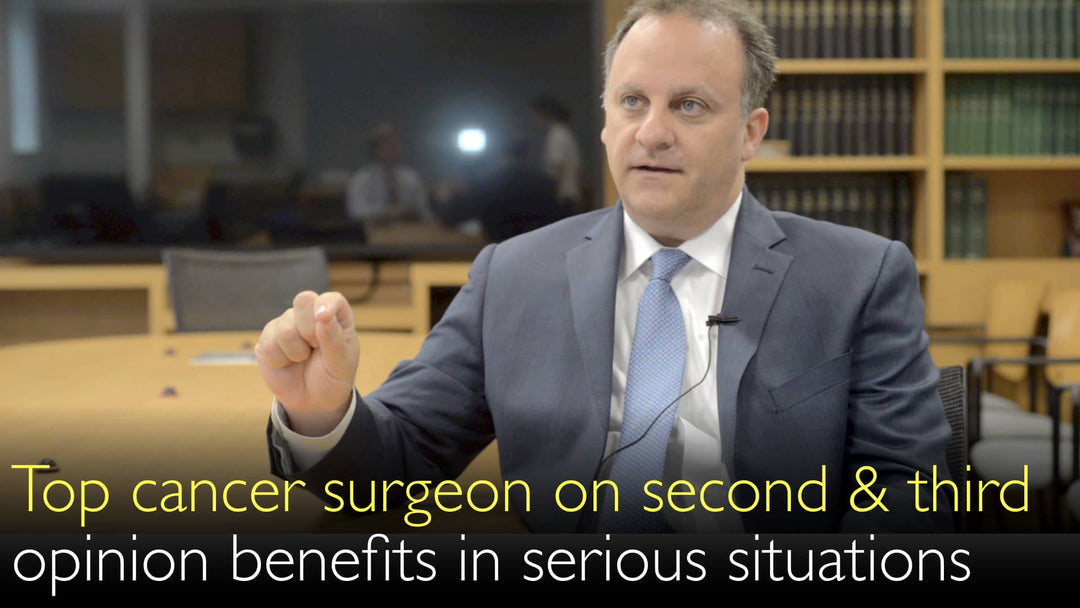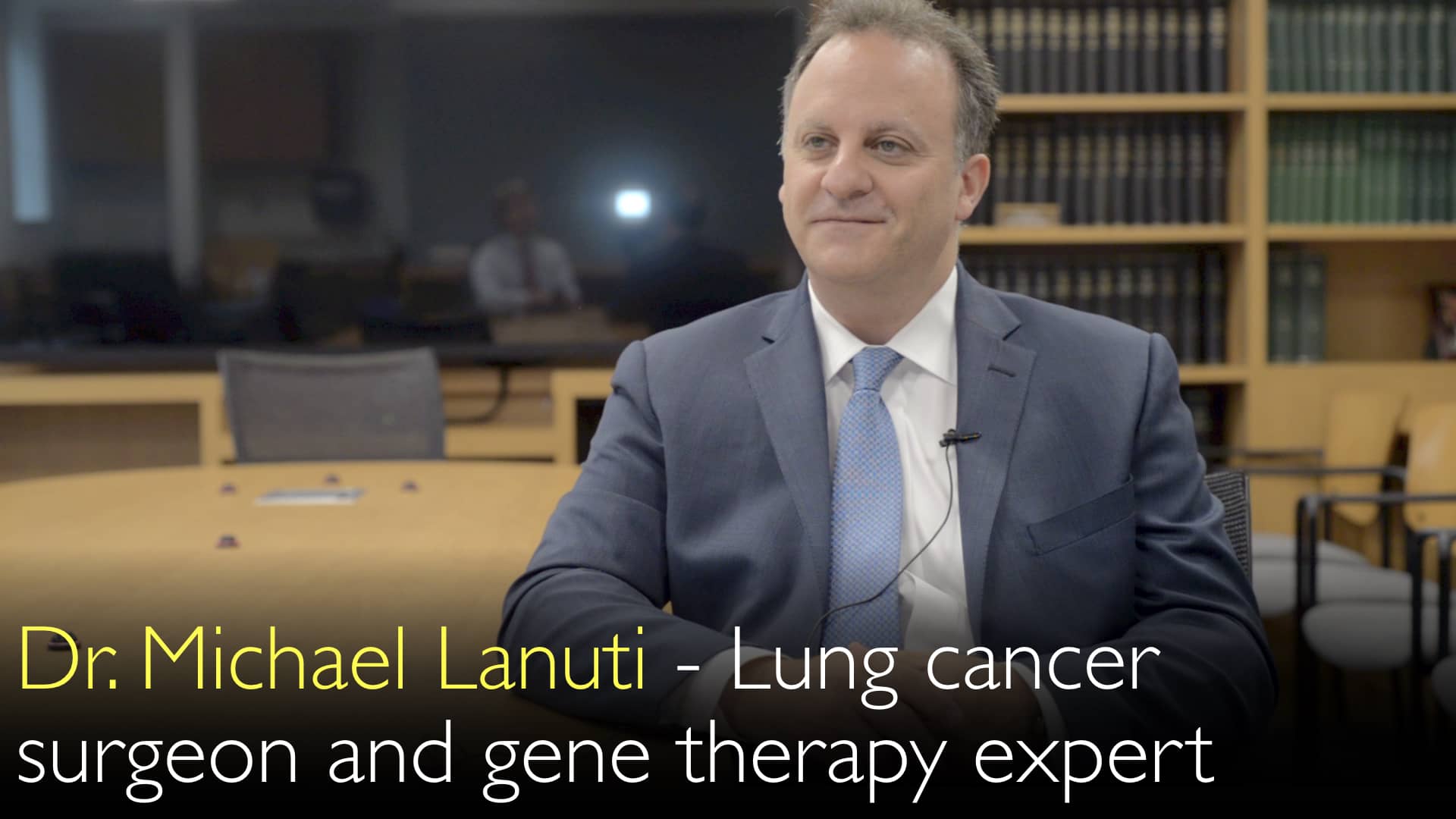המנתח החזה המוביל ומוחה לתרפיה גנטית ד"ר מייקל לנוטי, MD, מסביר מדוע קבלת חוות דעת רפואית שנייה היא קריטית עבור מצבים חמורים כמו סרטן ריאות ומפרט את האלגוריתמים האבחוניים המתוחכמים להערכת קשריות ריאתיות בודדות, תוך הדגשה כי החלטות הטיפול חייבות להיות מותאמות אישית להיסטוריה הייחודית של כל מטופל ולמאפיינים הספציפיים של הקשרית.
אבחון וטיפול בגוש ריאתי: מתי לפנות לחוות דעת שנייה
קפיצה לפרק
- החשיבות הקריטית של חוות דעת רפואית שנייה
- הבנת סוגי הגושים הריאתיים: מוצק לעומת תת-מוצק
- אלגוריתם אבחוני לגושים ריאתיים מוצקים
- טיפול בגושים ריאתיים תת-מוצקים (אטימות זכוכית מט)
- התאמת מסלול האבחון למטופל הספציפי
- היתרון בייעוץ עם מומחה לגושים ריאתיים
החשיבות הקריטית של חוות דעת רפואית שנייה
ד"ר מייקל לנוטי, MD, תומך מאוד בהמלצה למטופלים לפנות לחוות דעת רפואית שנייה או אף שלישית כאשר הם מתמודדים עם אבחנה משמעותית. הוא מציין כי דעותיהם של מנתחים עשויות להשתנות ולהתפתח עם הזמן, מה שהופך ייעוצים מרובים לשלב חיוני בהבטחת החלטת הטיפול המיטבית. ד"ר מייקל לנוטי, MD, מדגיש כי תהליך זה אינו מזיק ויכול לספק ערך עצום, במיוחד כאשר מטופל צריך להרגיש בנוח עם הצוות הרפואי שלו.
ד"ר אנטון טיטוב, MD, המראיין, מסכים ומשתף כי זה היה נכון גם בניסיונו האישי. ד"ר מייקל לנוטי, MD, מסביר כי מנתחים מיומנים ניתן למצוא ברחבי העולם, אך שיקול הדעת שלהם אינו קבוע. מטופל בן 84 עם סרטן ריאות עשוי להיחשב כמועמד לניתוח על ידי מנתח אחד אך לא על ידי אחר. מציאת מנתח עם ניסיון רחב בכל גילי המטופלים היא קריטית, וזו מושגת לרוב בצורה הטובה ביותר במרכזים רפואיים אוניברסיטאיים גדולים.
הבנת סוגי הגושים הריאתיים: מוצק לעומת תת-מוצק
הגישה לגוש ריאתי בודד שהתגלה בסריקת CT היא אמנות מורכבת ברפואה. ד"ר מייקל לנוטי, MD, מבהיר כי רופאים חייבים ראשית להבחין בין שני הסוגים העיקריים של גושים ריאתיים: מוצק ותת-מוצק. גוש תת-מוצק מתואר frequently גם כאטימות זכוכית מט (ground-glass opacity) בהדמיה. לגושים מוצקים יש מסלול אבחוני שונה מזה של גושים תת-מוצקים, וקריטי להבין שגוש אינו necessarily סרטן.
אלגוריתם אבחוני לגושים ריאתיים מוצקים
לגוש ריאתי מוצק קטן מתחת ל-8 מילימטרים במטופל ללא היסטוריה של סרטן, ד"ר מייקל לנוטי, MD, מסביר שהשלב הראשוני הוא usually מעקב עם סריקת CT חוזרת תוך שלושה חודשים כדי לבדוק גדילה. גושים ריאתיים מוצקים שגדלים הם always חשודים ובדרך כלל דורשים התערבות. סריקת PET CT יכולה לשמש להערכת הפעילות המטבולית של הגוש, שכן סרטן ריאות נוטה לקלוט avidly את החומר הרדיואקטיבי (גלוקוז מסומן).
תוצאה PET חיובית מכוונת את המנתח לגישה אגרסיבית יותר, כמו הסרה כירורגית אם המטופל מתאים. עם זאת, גוש מוצק שהוא PET CT שלילי may לאפשר לצוות הרפואי לסגת ולהמשיך במעקב. המפתח, כפי שד"ר מייקל לנוטי, MD, מציין, הוא שהחלטות אלו אינן מתקבלות מתוך "ספר בישול" אלא מותאמות individually.
טיפול בגושים ריאתיים תת-מוצקים (אטימות זכוכית מט)
גושים ריאתיים תת-מוצקים או גושי זכוכית מט מטופלים very differently מעמיתיהם המוצקים. ד"ר מייקל לנוטי, MD, מתאר אותם כ either שינויים דלקתיים או כמקדימים לסרטן ריאות. גושים אלו נפוצים both במעשנים ולא-מעשנים ודורשים ערנות long-term כי הם יכולים להתפתח לסרטן over many years.
אסטרטגיית הטיפול בגושים תת-מוצקים יציבים involves מעקב בהדמיה. אם גוש יציב בסריקה תוך שלושה חודשים, הסריקה הבאה might להיות מתוזמנת לשישה חודשים לאחר מכן. אם הוא נשאר יציב for a longer period, סריקות CT שנתיות are often sufficient. ד"ר מייקל לנוטי, MD, מציין שהוא יעקוב after גוש זכוכית מט for years. המדדים הקריטיים לפעולה are if הגוש מתחיל לגדול או, חשוב more, if הוא מפתח רכיב מוצק חדש, what suggests סרטן פולשני and necessitates הסרה כירורגית.
התאמת מסלול האבחון למטופל הספציפי
נושא central בהסברו של ד"ר מייקל לנוטי, MD, הוא absolute necessity להתאמת תוכנית האבחון והטיפול למטופל הספציפי. הוא נותן דוגמה clear: מטופל עם היסטוריה של סרטן מעי גס that presents with גוש ריאתי מוצק חדש will להיות מטופל much more aggressively than מעשן מעולם שלא- with no היסטוריית סרטן that has גוש באותו הגודל. גישה personalized זו ensures that משאבים משמשים effectively and מטופלים מקבלים טיפול appropriate לרמת הסיכון שלהם.
ד"ר אנטון טיטוב, MD, מדגיש כי בכל ענף של אלגוריתם האבחון, there is a שלב decision-making סובייקטיבי based on ידע וניסיון של רופא. ד"ר לנוטי מסכים completely, ומציין כי complexitas זו is why ייעוץ מומחה is so valuable.
היתרון בייעוץ עם מומחה לגושים ריאתיים
ד"ר מייקל לנוטי, MD, conclude כי רופאי משפחה are often not equipped להתמודד עם nuanses של אבחון גושים ריאתיים, and even pulmonologists who do not focus on תחום זה daily may benefit from ייעוץ מומחה. התייעצות עם specialist that מטפל בגושים ריאתיים every day can be highly advantageous, חוסכת from מטופלים procedures unnecessary, מפחיתה חרדה, and שולטת בעלויות הבריאות.
חוות דעת מומחה זו can frequently להתקבל remotely. ד"ר לנוטי confirms כי הצוות שלו regularly בודק סריקות CT חיצוניות from across the world to לספק המלצות how to להמשיך עם גוש ריאתי that נמצא. As מומחים במחלות ריאה, they are well-suited לקבל החלטות אבחון קריטיות אלו, what מדגיש the immense value of פנייה לחוות דעת second opinion ממומחה.
תמליל מלא
ד"ר אנטון טיטוב, MD: מנתח סרטן ריאות מוביל ומומחה לטיפול גנטי דן בהחלטות הטיפול הרפואי הטובות ביותר. How to לקבל את הטיפול הטוב ביותר for any מחלה serious? You must לקבל חוות דעת רפואית second. Sometimes you need לקבל חוות דעת רפואית third.
למנתחים יש דעות different. דעות של מנתחים change in time.
ד"ר מייקל לנוטי, MD: I think that you've articulated a very important point. Sometimes there is an important life decision for someone. To get a second opinion doesn't hurt you. Traveling for a medical second opinion sometimes might help you.
You've brought up a very good point of being comfortable with your team. You need to consider a second or sometimes third opinion. Not only a medical second opinion, but a third opinion, and however many it takes.
ד"ר אנטון טיטוב, MD: Correct.
ד"ר מייקל לנוטי, MD: And it was certainly true in our situation. Correct. Surgeons are different all over the world. I think well-trained surgeons can be found everywhere in the world. And surgeons have their own judgment.
Judgment of a surgeon is something that's not constant. Sometimes a patient who is 84 years old presents with lung cancer to one surgeon. The same patient then presents to a second surgeon. Both of these cancer surgeons might have different opinions. They may think the patients are candidates for surgery.
You're looking for someone who has a range of experience across all ages of patients. You are still going to get the best cancer treatment in larger universities.
ד"ר אנטון טיטוב, MD: It is common to find a single nodule in a lung on a CT scan. What to do with solitary pulmonary nodules is controversial. How do you approach solitary pulmonary nodules when you are consulted?
What is the general diagnostic algorithm? What people should know about pulmonary nodules?
ד"ר מייקל לנוטי, MD: That's a real art in the field. I think people cannot understand management of lung nodules very well. Physicians perhaps order too many diagnostic studies too fast.
Patients often present with a single nodule in the lung. We have to differentiate the type of lung nodule. There are nodules that are “solid". There are nodules that we call “sub-solid". Another term that you might see is "ground-glass" nodule, which is sub-solid.
Solid nodules have a different diagnostic algorithm than sub-solid nodules. Solid lung nodules can be several things, not necessarily cancer. It depends on where you are in the world.
Sometimes you see a single lung nodule. If it's under 8 millimeters we generally say "you need another interval scan”. We have to see if that lung nodule changes. Someone who had no history of cancer.
And the important thing here is that you really tailor the diagnostic path to the patient. There isn't any one cookbook way that you can say "every patient has to follow this diagnostic path".
I'll give you an example. Sometimes the patient comes to me. This patient had a history of colon cancer. This patient now has a solid lung nodule.
I'm going to manage that lung nodule very differently than in someone who never had cancer and who now has a solid lung nodule. So small solid lung nodules in someone who has never had cancer are diagnosed in this way.
Let's say they are a nonsmoker. We would usually get an interval scan in three months and see what it looks like. Solid lung nodules that grow are always suspicious.
Then the surgeon has to decide. Do you need a tissue biopsy? Or do you remove it? Most of the time we say, "Things that are growing in the lung should be removed if patients are candidates for surgery."
We can employ the use of a PET CT scan to look at the functionality of the lung nodule. Lung cancer tends to pick up the radioactive glucose that's given with a PET CT scan. That would point the surgeon more towards an aggressive approach.
Sometimes a solid lung nodule is PET CT negative. Such a lung nodule tends to make you pull back a little bit on a solid nodule. Again, you tailor diagnostic tests and therapy to the patient.
The flip side is we're seeing now many sub-solid lung nodules. Ground glass opacity nodules. Those are managed very differently.
ד"ר אנטון טיטוב, MD: What are sub-solid lung nodules?
ד"ר מייקל לנוטי, MD: They are either inflammatory or they can be precursors to lung cancer. And many people have sub-solid lung nodules, whether you're a smoker or not.
If you find sub-solid lung nodules, you can never stop watching them. Because sub-solid lung nodules can always over the years develop into a lung cancer. Some sub-solid lung nodules are so slow.
It takes three years for sub-solid lung nodules to start to grow. We've seen them take seven years to grow. But sub-solid lung nodules we manage a lot of time with surveillance imaging.
If sub-solid lung nodules are stable at three months, we then move the next chest CT scan to six months. If sub-solid lung nodules are really stable for a while, we get a CT scan once a year. And so I will follow a ground-glass nodule for years with an annual scan.
Whenever they start to grow, or if they ever start to develop a solid component, that's an indicator for an invasive cancer. That's where the treating team would say you need to do something about it.
Oftentimes we would say, "remove it surgically", if they're a candidate.
Dr. Anton Titov, MD: אז יש ניואנסים באבחון קשריות ריאה תת-מוצקות. קיים אלגוריתם כללי שתיארת, אך בכל שלב, בכל ענף של האלגוריתם, יש גם שלב קבלת החלטות סובייקטיבי מאוד, אם כי עדיין סובייקטיבי. הוא מבוסס על ידע וניסיון.
Dr. Michael Lanuti, MD: מסכים, ולכן אני חושב שרופאי המשפחה אינם מצוידים לאבחן קשריות ריאה. רופאי ריאות יודעים יותר, אך אם הם עושים זאת כל הזמן, בדרך כלל הם לא יכולים להוציא יותר מדי כסף ולטפל בקשריות ריאה ביעילות.
אני בהחלט חושב שנותני שירותים שאינם עושים זאת מדי יום צריכים כנראה להתייעץ עם מומחה. אז זו עוד דוגמה למצב שבו התייעצות עם מומחה יכולה להיות מועילה מאוד. זה יכול לחסוך הרבה צרות והרבה כסף עבור אנשים.
Dr. Anton Titov, MD: חוות דעת מומחה יכולה להתבסס על סריקות ה-CT, אפילו מרחוק.
Dr. Michael Lanuti, MD: כן. למעשה, פעמים רבות מתבקשים我们从我们来 סקור סריקות CT ריאה חיצוניות מכל העולם. אנחנו מחליטים מה לעשות עם קשריות הריאה הללו.
ואני חושב שבתור המומחים לריאה, אנחנו מתאימים היטב לאבחון סרטן ריאה בקשריות ריאה בודדות.





